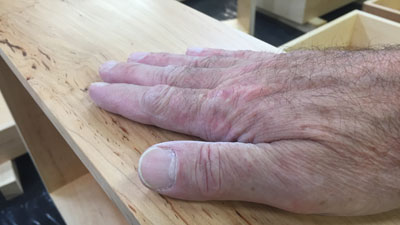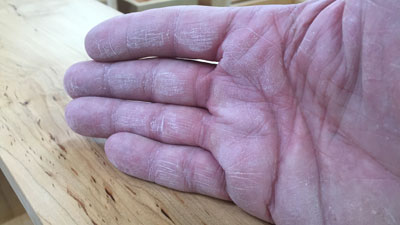
 by Steven D. Johnson
by Steven D. Johnson
Racine, Wisconsin
This month:
•
Dust Lubricant
•
Tack Cloth Replacement
•
People Watching
•
Epic Stupidity
Dust Lube
Click on any picture to see a larger version.
Sanding with a super fine grit paper after a coat of finely applied finish will often result in a surface that feels as smooth as… well… hmmm… several metaphors come to mind, but none are fit for print. Anyway, it feels slick… really slick… But look at your hand after wiping it across the surface. Chances are that coating of ultrafine dust (which is probably just residue of the finish you are applying) is acting as a lubricant on the surface of the wood making it feel slicker than it really is.

|
Figure 1 - This is how we all check the progress
of our sanding...
|
Remove the dust carefully and completely. Wash and dry your hands. Now feel the surface again. This is the best way to judge whether or not you are ready for the next coat of finish. Better yet, loosely wipe a microfiber cloth across the surface. Imperfections or inconsistencies in your sanding and even miniscule surface roughness will be revealed. The microfiber cloth will feel as if it is "snagging" as it moves across the surface.

|
Figure 2 - ...but the dust acts as a lubricant, making the
surface feel "slicker" than it really is
|
Dust is an excellent lubricant in the woodshop. I know, I know, we work so hard to keep dust at bay, but the truth is, it can also be used to advantage. Most woodworkers have experienced what I call the "perfect face" on a board. That is the board that is so perfectly flat that when placed on a perfectly flat cast iron tool top it literally "snicks" into place, and is very difficult to move… its fit to the flat machine top is so precise there is no airspace and a vacuum effect is the result. Happens all the time on my jointer. An 8-inch wide board that is perfectly flat is very difficult to slide down the table. When it starts to feel too much like work, I take a pinch of sanding dust (sometimes called "wood talc") and toss it on the tool top, and the board slides much more easily. You do keep a few bottles of wood talc around, don't you?
(Page 1 of 4)
1
2
3
4
Next Page
Return to
Wood News
front page

